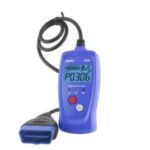Experiencing your car’s engine temperature gauge creeping into the red zone can be a heart-stopping moment for any driver. It’s a clear signal that something is wrong under the hood. But What Does Engine Temperature Hot Mean exactly? It signifies that your engine is overheating, a serious condition that can lead to significant damage if not addressed promptly. Think of it as your car screaming for help, indicating that the delicate balance of heat management within its complex system has been disrupted.
Engine overheating is more than just an inconvenience; it’s a critical issue that threatens the longevity and performance of your vehicle. Understanding the causes, recognizing the signs, and knowing how to react are crucial for every car owner. Let’s dive into why your engine might be running hot and what you need to do about it.
Decoding “Engine Temperature Hot”: Common Causes of Overheating
When your dashboard temperature gauge warns you of a hot engine, it means the engine is generating more heat than its cooling system can handle. This imbalance can stem from various malfunctions within the cooling system or related engine components. Here are some of the most frequent culprits behind an overheated engine:
Cooling System Leaks: The Silent Drain
Your car’s cooling system relies on a closed-loop circulation of coolant to dissipate heat from the engine. Leaks in this system are a primary cause of overheating. Coolant leaks can occur in several places:
- Hoses: Over time, radiator hoses can become brittle, cracked, or loose at the connections, leading to coolant seepage or significant leaks.
- Radiator: The radiator itself can be punctured by road debris, corroded internally, or develop leaks at its seams.
- Water Pump Gasket or Seals: The water pump, responsible for circulating coolant, has gaskets and seals that can fail, resulting in leaks.
- Head Gasket: A blown head gasket, while more serious, can also cause coolant leaks, often accompanied by other symptoms like white smoke from the exhaust.
- Expansion Tank/Reservoir: Cracks in the expansion tank or reservoir can lead to coolant loss.
Even a small coolant leak can gradually reduce the system’s efficiency, eventually leading to overheating, especially under demanding driving conditions or hot weather.
Alt text: Checking the coolant level in a car radiator, a key step in preventative car maintenance.
Faulty Water Pump: Circulation Interrupted
The water pump is the heart of your car’s cooling system. It’s a mechanical pump driven by the engine, responsible for continuously circulating coolant throughout the engine and radiator. If the water pump malfunctions, coolant flow is disrupted, and heat can build up rapidly. Common water pump failures include:
- Impeller Damage: The impeller, a fan-like component inside the water pump, can corrode, crack, or break down over time. A damaged impeller can’t effectively push coolant.
- Bearing Failure: Water pumps have bearings that allow them to spin freely. These bearings can wear out, causing the pump to seize or rotate erratically, hindering coolant circulation.
- Belt Issues: If the belt driving the water pump (often a serpentine belt) is loose, cracked, or broken, the water pump may not function properly.
A failing water pump can quickly lead to an overheated engine, often requiring immediate professional attention.
Radiator Problems: Heat Exchange Compromised
The radiator acts as the heat exchanger in your car’s cooling system. It dissipates heat from the hot coolant returning from the engine, cooling it down before it recirculates. Radiator issues can significantly impair this heat exchange process:
- Internal Blockages: Mineral deposits, rust, and debris can accumulate inside the radiator’s narrow passages over time, restricting coolant flow and reducing its cooling capacity.
- External Blockages: Leaves, bugs, and road debris can clog the radiator fins on the outside, hindering airflow and reducing its ability to dissipate heat.
- Damaged Fins: Bent or damaged radiator fins reduce the surface area available for heat exchange, making the radiator less efficient.
- Radiator Fan Malfunction: The radiator fan, usually electrically powered, draws air through the radiator, especially when the car is stationary or moving slowly. A faulty fan, fan motor, or fan clutch can reduce airflow and lead to overheating in stop-and-go traffic.
Alt text: Close-up of car radiator fins, essential for dissipating engine heat through air flow.
Low Engine Oil Level: Lubrication and Cooling Deficiency
Engine oil is not just for lubrication; it also plays a role in engine cooling. As oil circulates, it absorbs heat from engine components and helps to dissipate it. When engine oil levels are low, several problems arise:
- Increased Friction: Insufficient lubrication leads to increased friction between moving engine parts, generating more heat.
- Reduced Heat Transfer: Less oil means less heat is carried away from critical engine areas.
- Oil Breakdown: Overheated oil loses its lubricating properties and can break down, further exacerbating friction and heat buildup.
Regular oil changes and monitoring your oil level are crucial for both lubrication and heat management within the engine.
Thermostat Failure: Gatekeeper Malfunction
The thermostat is a valve that regulates coolant flow based on engine temperature. It’s designed to remain closed when the engine is cold, allowing it to reach operating temperature quickly. Once the engine is warm, the thermostat opens, allowing coolant to circulate to the radiator for cooling. Thermostat failures can lead to overheating in two primary ways:
- Stuck Closed: If the thermostat is stuck closed, coolant cannot flow to the radiator, and the engine will overheat rapidly. This is a common cause of sudden overheating.
- Stuck Open (Less likely to cause overheating directly, but can contribute): While less likely to cause overheating directly, a thermostat stuck open can prevent the engine from reaching its optimal operating temperature, potentially affecting fuel efficiency and emissions, and in some cases, indirectly contributing to cooling system inefficiencies over time.
Recognizing the Red Flags: Signs of Engine Overheating
Catching engine overheating early can prevent serious damage. Be alert to these warning signs:
- Steam or Smoke from Under the Hood: This is often the most dramatic and obvious sign. Steam, which may look like white smoke, indicates boiling coolant escaping the system. It may be accompanied by a sweet smell of coolant.
- Temperature Gauge in the “Red Zone” or “H”: Your dashboard temperature gauge is your primary indicator. If it climbs rapidly towards the “H” (Hot) mark or enters the red zone, your engine is overheating. Familiarize yourself with your vehicle’s gauge markings in your owner’s manual.
- Unusual Burning Smell: Overheated components can produce a distinct burning smell. This could be the smell of hot coolant, burning oil, or hot metal.
- Weak Engine Performance or Unusual Noises: In some cases, overheating can cause a noticeable loss of engine power or unusual knocking or pinging noises.
Alt text: A car dashboard temperature gauge showing the needle pointing to the ‘H’ or hot mark, indicating engine overheating.
Immediate Response: What to Do When Your Engine Overheats
If you suspect your engine is overheating, act quickly and safely:
- Turn off the Air Conditioner and Turn on the Heater: The air conditioner puts extra load on the engine. Turning it off reduces heat generation. Turning the heater on full blast, paradoxically, can help draw heat away from the engine compartment and into the passenger cabin, providing a temporary measure to dissipate some engine heat.
- Safely Pull Over and Stop: Find a safe location to pull off the road immediately. Turn off the engine and allow it to cool down.
- Let the Engine Cool Down (At Least 15-20 Minutes): Do not attempt to open the hood immediately. Wait at least 15-20 minutes for the engine temperature to decrease. Keep an eye on the temperature gauge; it should start to move back towards the normal range as the engine cools.
- Check Coolant Level (If Safe and You Know How): Only after the engine has cooled significantly, and if you are comfortable doing so, carefully check the coolant level in the expansion tank or radiator (if accessible). Never open the radiator cap when the engine is hot, as pressurized hot coolant can erupt and cause severe burns. If the coolant level is low, and you have extra coolant or water, you can carefully add some, but this is only a temporary fix.
- Consider Restarting (Cautiously): After allowing sufficient cooling time, and if the temperature gauge has returned to a more normal range, you can attempt to restart the engine. Keep a close watch on the temperature gauge. If it starts to climb again quickly, pull over immediately and turn off the engine. If the temperature remains stable, you may be able to carefully drive to the nearest repair shop. However, it’s always safer to have the vehicle towed.
Critical Mistakes to Avoid During Engine Overheating
- Don’t Panic: Stay calm and focused. Panic can lead to unsafe driving decisions.
- Don’t Keep Driving: Continuing to drive an overheating engine will likely cause severe and expensive damage, such as a warped cylinder head, blown head gasket, or even engine seizure.
- Don’t Open the Hood Immediately: Hot steam and coolant can cause serious burns. Wait for the engine to cool down before opening the hood.
- Don’t Ignore the Problem: Engine overheating is a symptom of an underlying issue. Ignoring it will only lead to further problems and potentially major engine damage.
Prevention: Keeping Your Engine Running Cool
Preventing engine overheating is far better than dealing with the consequences. Regular maintenance is key:
- Regular Coolant Flushes and Checks: Follow your vehicle manufacturer’s recommendations for coolant flushes (typically every 2-5 years or a certain mileage interval). Regularly check your coolant level and condition.
- Inspect Hoses and Belts: Have your hoses and belts inspected for cracks, leaks, and wear during routine maintenance.
- Radiator Maintenance: Keep the radiator exterior clean of debris. Consider professional radiator cleaning or flushing as part of preventative maintenance.
- Regular Oil Changes: Adhere to your vehicle’s recommended oil change intervals.
- Monitor Temperature Gauge Regularly: Make it a habit to glance at your temperature gauge periodically while driving, especially in hot weather or during heavy traffic.
By understanding what does engine temperature hot mean and taking proactive steps, you can protect your engine, avoid costly repairs, and ensure a smoother, more reliable driving experience. If your engine has overheated, or if you suspect a cooling system issue, it’s essential to have your vehicle inspected by a qualified mechanic as soon as possible.

